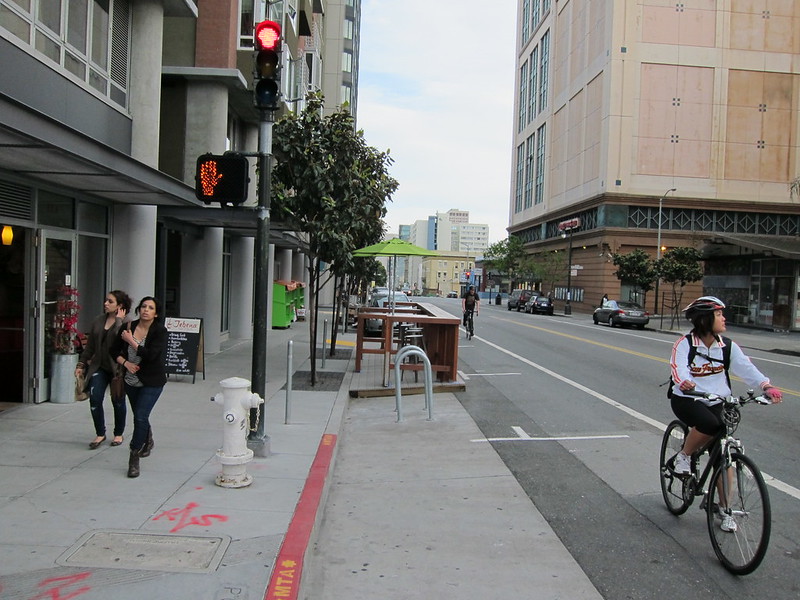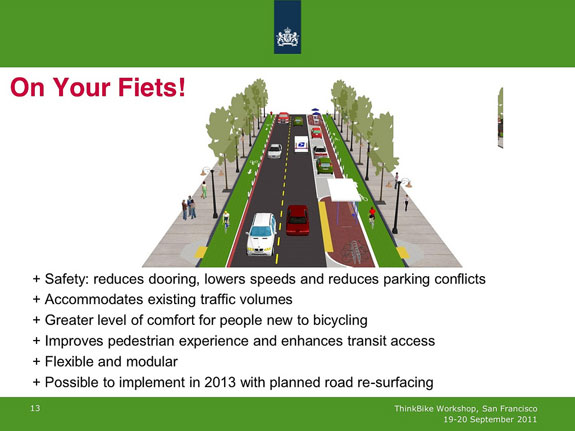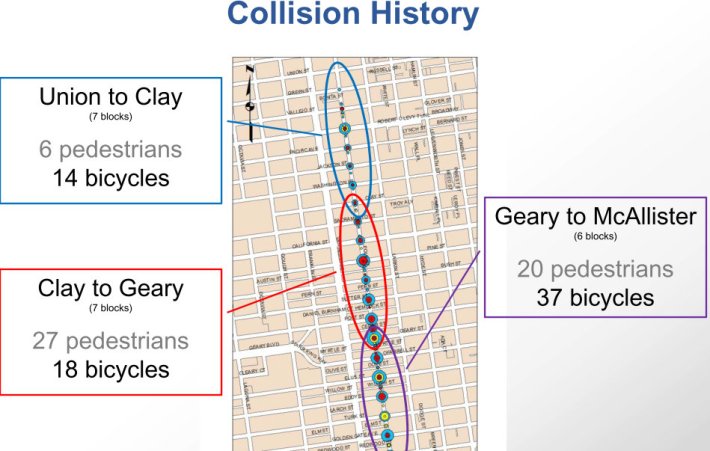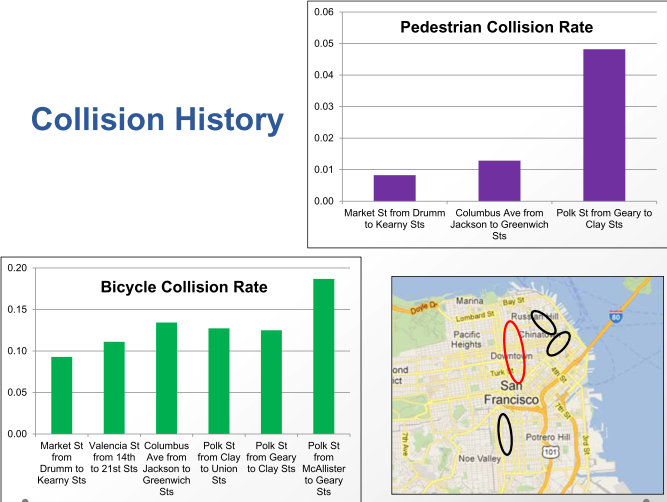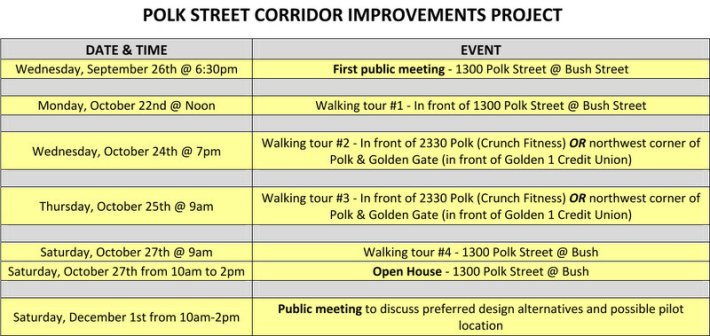SFMTA Sets Out to Create a Safer, More Convivial Polk Street
3:43 PM PDT on September 28, 2012
An effort to revamp conditions on Polk Street for walking, socializing, bicycling, and transit is underway by the SF Municipal Transportation Agency, and residents say they're eager to see calmer motor traffic, wider sidewalks, better bike lanes and more public space along the corridor.
At a well-attended SFMTA community meeting on Wednesday, planners said construction on the redesign of Polk, between McAllister (at City Hall) and Union Streets, could start by early 2015, though a pilot project could also be implemented to test ideas on the ground by the time America's Cup races return next July. That project will be developed in future community meetings, but it could result in anything from temporarily widened sidewalks, to restrictions on car traffic, to protected bike lanes. Roughly $8 million in Prop B street improvement bonds are already devoted to the pilot, in addition to street repaving funds.
D3 Supervisor David Chiu, who has lived near Polk for 16 years, walks and bikes the street regularly. "It's an experience that can absolutely be improved," he said. "This corridor has enormous potential to be a 21st-century model of transit-first living. Whether it be ideas around pedestrian safety, around bike lanes, parklets, or bulb-outs, in ways that allow all for all the modes of transit to be used and builds community, the conversation is very exciting."
Polk was one of the corridors where Dutch bicycle planners joined the SFMTA on a ride one year ago to re-imagine it as a more pedestrian- and bicycle-friendly street using methods practiced in the Netherlands, which is known for its exceptionally safe street designs. The recommendations that resulted included expanding pedestrianized areas and providing continuous, parking-protected bike lanes -- an idea also called for in the SF Bicycle Coalition's Connecting the City campaign as a safe, relatively flat connection linking Market Street to Fort Mason and Fisherman's Wharf.
Although calls for physically separated bike lanes didn't seem as prevalent at the Polk meeting as they were at a similar community workshop on improving Second Street in May (at that meeting, groups of attendees were able to actually propose street layouts), residents did say they'd like generally to see bike lanes improved and extended along the entire stretch of Polk.
SFBC Executive Director Leah Shahum said the robust interest in major changes on Polk was encouraging. "I heard from neighbors, business owners, people who work here, that they all see a lot of potential for streetscape improvements to increase the liveliness and draw of the street," she said. "A lot of people value the diversity of the street, but also feel like the streetscape isn't living up to its potential."
Intersected by a number of wide, high-speed, one-way streets, Polk sees an unusually high rate of pedestrian and bicyclist injuries. From 2006 to 2011, 20 pedestrians and 37 bicyclists were hit on the six blocks between McAllister and Geary Boulevard alone, according to data provided by the SFMTA from the Statewide Integrated Traffic Records System (SWITRS).
For bicyclists, that's a rate of roughly 0.17 crashes per bike, when divided by peak hour bike traffic counts. By comparison, the crash rate on Market Street from Drumm to Kearny Streets is about 0.08, and for Valencia Street from 14th to 21st Streets, it's about 0.11. Columbus Avenue between Jackson and Greenwich streets saw a rate of 0.13.
The differences in pedestrian crash rates are even more pronounced. The crash rate on those same six blocks of Polk is about five times higher than on the previously mentioned stretches of Market and Columbus. "Polk is one of the 7 percent of city streets where the most serious and fatal pedestrian collisions happen," said Walk SF Executive Director Elizabeth Stampe. "Tools like bulb-outs on those corners could do a lot to make the entire corridor safer."
With development projects in the works like the nearby California Pacific Medical Center Cathedral Hill Campus, Stampe said making changes ahead of time to improve pedestrian conditions while discouraging and calming car traffic on Polk should be a priority. CPMC is expected to help fund pedestrian and bike improvements in the area.
"This project is a great opportunity to both make the street safer and more comfortable and roomy, with calm traffic," said Stampe. "This is a shopping street, it's a neighborhood street, and it can feel kind of cramped because so many people are already walking there."
There was little discussion on how to improve service for the 19-Polk, though the Bus Rapid Transit route coming to the adjacent Van Ness Avenue is expected to provide faster, more reliable service along the corridor.
Chiu and Shahum likened Polk to Valencia Street in the Mission, where a streetscape revamp completed in 2009, which widened sidewalks, is largely credited for increasing foot traffic and boosting business. Both corridors have also been popular places for parklets in the past couple of years, revealing the huge demand for more public space.
Kinani Ahmed, owner of Jebena Cafe at Polk and Geary, said he initially faced resistance in the neighborhood when he proposed his parklet and bike corral, but that perceptions quickly changed after they were put in. These days, he said, neighbors "really appreciate what I've done."
"You know, there's no park out here," said Ahmed. "It's sort of a community area where people can just enjoy the outdoors and have some greenery. This was a corner that a lot of people avoided... I think it helps that when people are sitting down and watching the activity, it deters the negative element from happening because there's a presence of people."
To continue fielding community input, the SFMTA has already scheduled four walking tours leading up to the next street design workshop on October 27, followed by another meeting on December 1 where planners will propose a preferred design.
Compared to the SFMTA's past planning processes for street improvement projects, Shahum said it was promising to see the relatively quick schedule already laid out, including so many walking tours, as well as the $8 million in funds already dedicated to the pilot project. "It's clear that [city staffers] really want to see change happen, and that they're committing to a timeline that's ambitious and smart," she said. "If you drag a project out too long, you lose people's engagement, and you lose their confidence."
Read More:
Stay in touch
Sign up for our free newsletter
